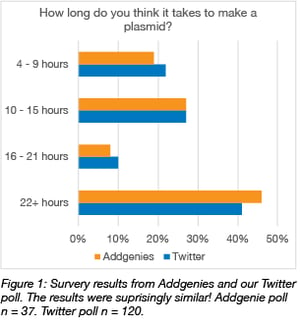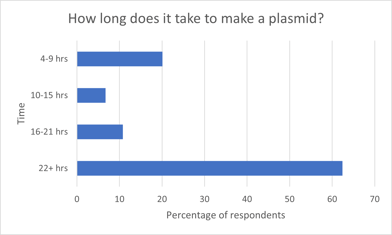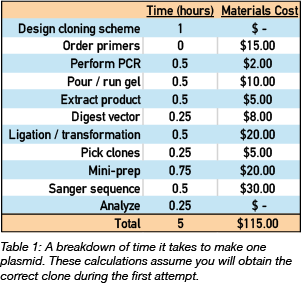This post was originally written by Jennifer Tsang and updated by Rachel Leeson.
Have you ever wondered how long it takes to make a plasmid? Or how much time you have to spend cloning before you can start your experiment? What about all the reagents you need to order? Sometimes, it feels like an eternity of cloning, waiting, and repeating before you can finally dive deep into generating the data you’re excited about.
When we were closing in on the one million plasmids shared milestone in 2018, we wrote a post on the time and cost required to make a plasmid. In 2023 (and at closer to 2 million plasmids shared than not!), we think it’s about time we updated this post.
How much time does it take to make a plasmid?


Figure 2: Survey results from a Twitter poll run in 2023, n=194. |
After the great Plasmid Debate of ’18, Blue Flame depositor John Doench calculated the time to make a plasmid. Doench’s lab in the Broad Institute has created hundreds of thousands of plasmids, using both mass production genome wide screens and the more traditional “one at a time” approach.
According to his math, it takes five hours of hands-on time to make a single plasmid, based on the assumptions outlined in Table 1.

Of course, this is for the simple insertion of a PCR product into a vector. The time it takes to make a plasmid could increase dramatically if you are piecing together several PCR products together. And this assumes you did everything correctly the first time – no mistakes, no repeats!
How long does it take in total? While much harder to calculate, in both our 2018 and 2023 poll, most people said it took them more than 22 hours, so at least the better part of four days.
How much does it cost to make a plasmid?
Doench also calculated the cost of consumable reagents used to make a plasmid, which came out to $115/plasmid, excluding any restriction enzymes or vector purchases (Table 1). Restriction enzymes and vector purchases can raise the cost anywhere from a few dollars to over a hundred.
Of course, these were all 2018 numbers, and the intervening five years, inflation has occurred. Here at Addgene, the consumables cost per stab has increased 50% since 2019, while overall inflation of USD has gone up 19.8% in the same time period. For ease of calculations*, let’s split the difference and put scientific inflation at… roughly 34.9%, which means that the same plasmid would cost $155.25 in reagents and consumables today.
Finally, this doesn’t account for the most valuable component in science – the time spent by the scientists designing and performing the experiments. This cost varies hugely based on a number of factors, but we can assume it’s at least equal to the $155 spent on reagents.
Five ways to decrease plasmid production time and cost
If you’re short on money or time, there are a few options you can explore to maximize the use of both when making plasmids.
Use repositories
Repositories such as Addgene help share materials quickly and cheaply. We save you from having to make plasmids that already exist, and we significantly reduce costs of producing plasmids with high-throughput methods that save on reagents, consumables, and time. We also handle the MTA, QC the plasmids, provide helpful resources, and, on the rare occasion things go wrong, replace them for free. Plasmids ship out 2-3 days after ordering, making it a toss-up as to whether it’s faster to order or try to make it in your lab (but if you need a lot of plasmids, it’s almost always faster to order from us!)
Ask the PI
If you want a plasmid for free, you can always reach out to the PI or corresponding author of the paper it’s published in. That’s also a great way to get to know people doing interesting and relevant work in your field! However, there’s no guarantee you’ll get a response on the first try (or any response at all). And while this method is free for you, and many labs are quite happy to share, labs that get high volumes of plasmid requests can end up refusing such requests in order to preserve time and money for their own experiments.
Keep good records
Oftentimes, you’ll be able to use or build on work done previously, borrow small aliquots of restriction enzymes for one-off projects, or even save yourself hours by chatting quickly with the postdoc who’s really good at primer design – but first, you have to know what resources exist and where to find them! Keeping good records and an organized lab saves time and money across the board.
Consider alternative cloning strategies
There are many strategies beyond the traditional PCR/digest/ligate methods and picking the right one can save you time if you’re working at speed or money if budget is a concern. The faster methods, like Gibson assembly, are typically more expensive, so you’ll have to find a balance between time savings and budget savings that works for your experiment.
Make your work “high-throughput”
Instead of making one plasmid at a time, try constructing several plasmids in parallel. That way, you can run one PCR, one gel, etc. for multiple plasmids at once. Over time, this can save you a surprising amount of money in reagents and consumables, especially for things like plates and gels, which either don’t scale or have limited scaling. The downside of high-throughput work is that you give up a lot of flexibility in your workflow – the more you scale up, the harder it is to throw in last minute experiments or changes.
Fun fact: Addgene’s high-throughput approach means we virtually always use every single well in a 96-well (or 384-well) plate!
How much do repositories help?
Designing precise calculations for any of the numbers in this post is a mathematical story well beyond my ability to tell. But even from these rough estimates, it’s clear that community engagement with and use of repositories like Addgene provides large-scale savings. How large?
Using Doench’s calculations and the 2018 numbers for consumable costs, our depositors have helped us save the scientific community well over $80 million on plasmids alone. (And we expect that resources like our AAV Data Hub will help scientists save even more!) If you assume an average of 5 hours of hands-on time per plasmid, Addgene, since its founding in 2004, has saved the scientific community a collective and very cool 8,768,560 hours – or almost exactly 1000 calendar years!
*Dammit, man, I’m a scientist, not an economist!
Additional Resources on the Addgene Blog
- 5 factors to help you choose the right cloning method
- Find blog posts about scientific sharing here
- Download the Plasmids 101 eBook
Resources on Addgene.org
- Join the community of Addgene depositors here
- Check out our special collection pages to more easily find plasmids
- Search for a plasmid in Addgene’s repository
Topics: Plasmid Cloning, Plasmids





Leave a Comment